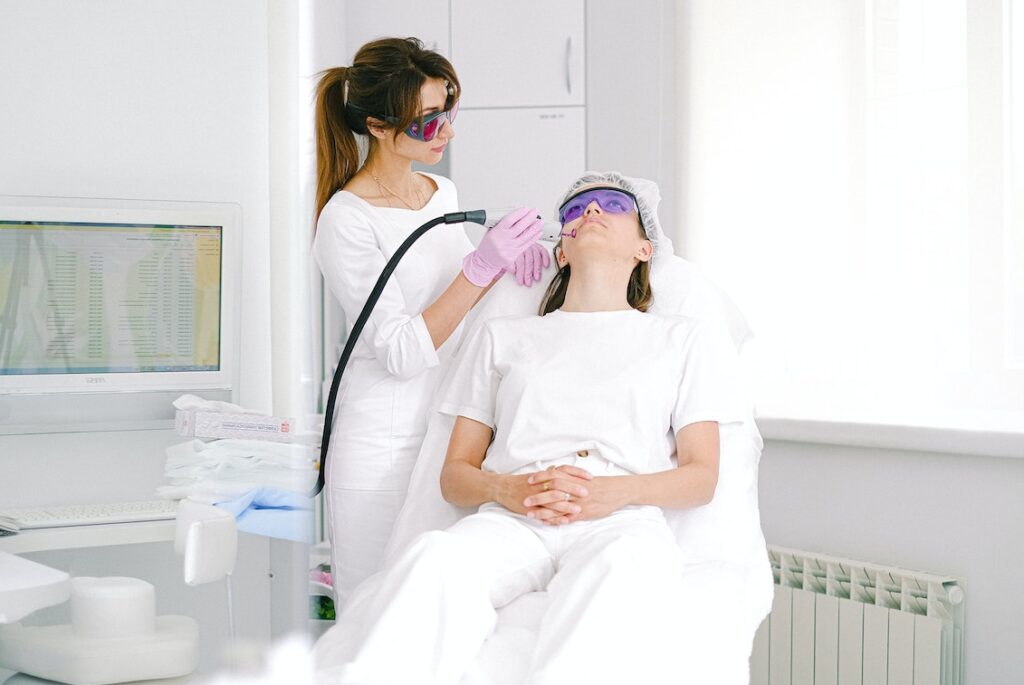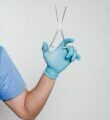A scar is tissue that has formed as a result of healing after damage to the dermis. It forms after surgery or injuries that damage the deeper layers of the skin. Our body tries to repair this as quickly as possible, so healing is imperfect and a scar forms. Scars are also very common after severe inflammatory acne, acne excoriée or smallpox.
In this article I will write about the treatments we doctors use to correct scars, not only after acne. We can use these methods separately, but they are combined and repeated for the best effect.
PRP – PLASMA THERAPY
This is great for promoting the healing of fresh scars, or as a complementary treatment after laser or chemical peels. This treatment involves taking a sample of your own blood and using a centrifuge to separate out platelet rich plasma. This is then injected into the scar and surrounding skin through tiny punctures to restart healing. After one more treatment, the healing process is greatly accelerated. I recommend repeating it at least 3-4 times in a row after a month.
PROFHILO and SKINBOOSTER
These treatments involve the injection of hyaluronic acid into the skin. The latest methods include the injection of polynucleotides (Nucleofill). These treatments are great for new scars because they start the healing process in the skin, with visible results often after the first or second treatment. For older scars, I apply these substances after first disrupting the scar tissue with a cannula (called a false subcision) to maximise the effect.
SUBCISION
True subcision is popular, especially abroad, where it is performed using a special Nokor needle. Scars are held together by fibrous bands that need to be broken to improve. This is especially true for deep, indented or wavy scars such as rolling and boxcar scars. Sometimes this treatment alone is sufficient, but it is often supplemented with hyaluronic acid, laser or other methods.
CHEMICAL PEELING WITH TRICHLOROACETIC ACID – superficial/cross TCA
I love TCA because it gives great results at an affordable price. It can be used all over the face (at a concentration of 30%) or spot treated on scars (concentration over 50%). However, full face application is not suitable for sensitive skin. Visible results can be seen after just one treatment, but it is often supplemented and repeated as part of a comprehensive approach to scar correction. I recommend repeating the treatment after three months at the earliest.
EXCISION (WITH A PUNCH)
Excision is the method of choice for sharp, punched-out scars such as ice-pick scars, boxcar scars and chickenpox scars. It can also be used to remove enlarged pores or ‘pits’ caused by acne. The scar is surgically removed and then stitched up. The resulting scar is much improved and usually blends in with the surrounding skin. It is often almost invisible, making further treatment easier. We allow it to heal and, if necessary, smooth it with laser treatment, microneedling or chemical peels.

ABLATIVE LASER – CO2, Erbium
It works on the principle of thermal damage to the skin, which stimulates its regeneration. Fractional laser treatment burns narrow columns into the skin (visible as a grid-like pattern). Immediately after the treatment, a healing process is triggered in the skin, resulting in the formation of new collagen and the remodelling of scars. This process takes a minimum of 3 months. Laser treatment is highly beneficial when combined with plasma therapy, mesotherapy, skin boosters or even Profhilo. This will greatly assist the healing process and provide the skin with sufficient building blocks for regeneration.
I recommend to have another ablative laser treatment after at least 6 months! Too early a treatment can interfere with the ongoing healing process. Repeating laser treatments too often is a mistake I have unfortunately made several times.
This treatment is not recommended for sensitive skin. Care should also be taken with fair skin types and those prone to hyperpigmentation. Ablative laser treatment should be carried out by an experienced professional, such as a dermatologist or plastic surgeon.
NON-ABLATIVE LASER
Although it doesn’t visibly burn the surface of the skin (unlike ablative lasers), it still causes thermal damage and stimulates collagen production. This treatment is suitable for more sensitive skin, but caution is still required. It should also be carried out by an experienced medical professional as, despite its appearance, it can cause damage and permanently sensitise the skin. As with ablative lasers, this treatment can be complemented with plasma therapy, mesotherapy, skin boosters or Profilo. This will greatly aid the healing process and provide the skin with sufficient building blocks for regeneration. An example of a non-ablative laser is ResurFX.
MICRONEEDLING
This is a method of disrupting the skin through small punctures with thin needles, thereby stimulating the process of skin renewal. During this treatment, your plasma or other mesotherapeutic cocktail is applied to the skin, reaching deeper layers and increasing the effect of the treatment. A major advantage is that the skin doesn’t burn and the healing process is relatively quick. This treatment works well in combination with skin boosters or Profhilo. I recommend it is repeated several times, with a gap of about 4-6 weeks between sessions. It is not recommended for fragile skin or people with easily broken capillaries.
MICRONEEDLE RADIOFREQUENCY
It can smooth out minor irregularities such as scars and wrinkles on the skin, while also tightening it. One of its advantages is rapid healing.
MEDICAL IPL
IPL treatment is an unrivalled method of treating post-inflammatory pigmentation or erythema. In other words, it is excellent for treating redness and brown spots after acne. It also stimulates some collagen production, although not enough to smooth deeper scars. Visible results can be seen after the first treatment, but usually need to be repeated every 4-6 weeks.
HYALURONIC ACID FILLER
This is used when we want to add volume to a scar and camouflage it. In some cases it is really the best option and can also complement the above methods. The filler is gradually absorbed, so it is very likely that you will need to have another treatment after one or two years.
USE OF CORTICOSTEROIDS
Diprophos or Depo-Medrol is injected into keloid scars. Corticosteroids cause them to shrink and become smoother. Care must be taken with this treatment to avoid the opposite effect, an atrophic scar. The substance is applied drop by drop to the upper layers of the scar, and I recommend a gentle pressure massage at home.


